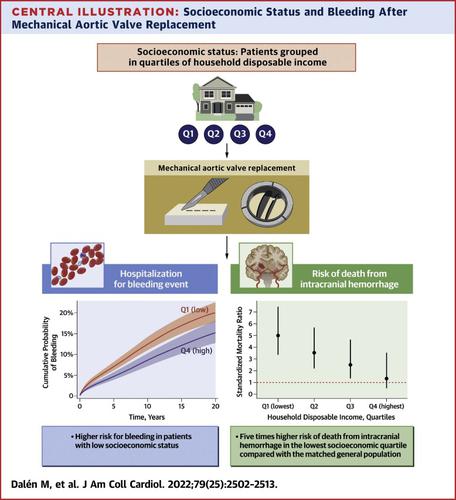Journal of the American College of Cardiology ( IF 24.0 ) Pub Date : 2022-06-20 , DOI: 10.1016/j.jacc.2022.04.030 Magnus Dalén 1 , Michael Persson 1 , Natalie Glaser 2 , Ulrik Sartipy 1

|
Background
Whether low socioeconomic status (SES) is associated with increased risk of anticoagulation-related adverse events in patients with mechanical heart valves is unknown.
Objectives
This study sought to investigate the impact of patients’ SES on the risk of bleeding after mechanical aortic valve replacement (AVR).
Methods
This nationwide population-based cohort study included all patients aged 18-70 years who underwent mechanical AVR in Sweden from 1997 to 2018. Data were obtained from the SWEDEHEART register and other national health data registers. The exposure was quartiles of household disposable income. The primary outcome was hospitalization for a bleeding event.
Results
Among 5974 patients, the absolute risk for bleeding after 20 years of follow-up was 20% (95% CI: 17%–24%) in the lowest income quartile (Q1) and 16% (95% CI: 13%–20%) in the highest quartile (Q4). The risk of bleeding decreased with increasing income level and was significantly lower in patients in income level Q3 (HR: 0.77; 95% CI: 0.60–0.99) and Q4 (HR: 0.68; 95% CI: 0.50–0.92) than Q1. The risk of death from intracranial hemorrhage was five times higher in the lowest income quartile than the age- and sex-matched general Swedish population (standardized mortality ratio: 5.0; 95% CI: 3.3–7.4).
Conclusions
We observed a strong association between SES and risk of bleeding among patients who underwent mechanical AVR. These findings suggest suboptimal anticoagulation treatment in patients with lower SES and the need for strategies to optimize anticoagulation treatment in patients with a mechanical heart valve. (Health-Data Register Studies of Risk and Outcomes in Cardiac Surgery [HARTROCS]; NCT02276950)
中文翻译:

机械主动脉瓣置换术后的社会经济状况和出血风险
背景
低社会经济地位 (SES) 是否与机械心脏瓣膜患者抗凝相关不良事件风险增加有关尚不清楚。
目标
本研究旨在调查患者的 SES 对机械主动脉瓣置换术 (AVR) 后出血风险的影响。
方法
这项以全国人群为基础的队列研究纳入了 1997 年至 2018 年在瑞典接受机械 AVR 的所有 18-70 岁患者。数据来自 SWEDEHEART 登记册和其他国家健康数据登记册。风险敞口是家庭可支配收入的四分位数。主要结局是因出血事件住院。
结果
在 5974 名患者中,在最低收入四分位数 (Q1) 和 16% (95% CI: 13%-20) 的 20 年随访后,出血的绝对风险分别为 20% (95% CI: 17%–24%) %) 在最高四分位数 (Q4)。出血风险随着收入水平的增加而降低,并且在收入水平 Q3(HR:0.77;95% CI:0.60-0.99)和 Q4(HR:0.68;95% CI:0.50-0.92)的患者中,出血风险显着低于 Q1。最低收入四分位数的颅内出血死亡风险是年龄和性别匹配的瑞典普通人群的五倍(标准化死亡率:5.0;95% CI:3.3-7.4)。
结论
在接受机械 AVR 的患者中,我们观察到 SES 与出血风险之间存在很强的相关性。这些发现表明,对于 SES 较低的患者,抗凝治疗并不理想,需要制定优化机械心脏瓣膜患者抗凝治疗的策略。(心脏手术风险和结果的健康数据登记研究 [HARTROCS];NCT02276950)


























 京公网安备 11010802027423号
京公网安备 11010802027423号